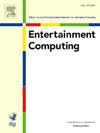Deep multimodal fusion for video game age rating classification
IF 2.4
3区 计算机科学
Q2 COMPUTER SCIENCE, CYBERNETICS
引用次数: 0
Abstract
Video games appeal to a wide range of ages, from children to adults. As a result, reliable age rating systems like the Entertainment Software Rating Board (ESRB) and Pan European Game Information (PEGI) are essential for guarding younger gamers from improper content. These organizations rate games based on content submitted by video game developers. This paper proposes a multimodal deep learning framework that predicts age ratings by analyzing both video game cover images and textual descriptions. A dataset of 39,212 games was constructed using publicly available information, including ESRB and PEGI labels. Both individual models based on visual or textual features and fusion models that combine these modalities using simple concatenation and Deep Canonical Correlation Analysis (DCCA) were employed to perform the classification task. Experimental results indicate that the simple concatenation model achieves the highest accuracy compared to the individual modalities and the DCCA-based approach, reaching 0.678 for ESRB prediction and 0.584 for PEGI prediction. The findings highlight that using only visual information has limitations, and that textual descriptions play an important role in determining the appropriate age rating for a game. This study shows that future research can benefit from using additional content like gameplay videos and audio.
视频游戏年龄分级的深度多模态融合
电子游戏吸引了从儿童到成人的各个年龄段的人。因此,像娱乐软件分级委员会(ESRB)和泛欧游戏信息(PEGI)这样可靠的年龄分级系统对于保护年轻玩家免受不当内容的影响至关重要。这些组织根据电子游戏开发者提交的内容对游戏进行评级。本文提出了一个多模态深度学习框架,通过分析视频游戏封面图像和文本描述来预测年龄等级。使用包括ESRB和PEGI标签在内的公开信息构建了39,212个游戏的数据集。使用基于视觉或文本特征的单个模型和使用简单连接和深度典型相关分析(DCCA)将这些模式结合起来的融合模型来执行分类任务。实验结果表明,与单个模式和基于dca的方法相比,简单串联模型的ESRB预测精度达到0.678,PEGI预测精度达到0.584。研究结果强调,仅使用视觉信息是有局限性的,文本描述在确定游戏的合适年龄分级方面发挥着重要作用。这项研究表明,未来的研究可以从使用游戏视频和音频等附加内容中获益。
本文章由计算机程序翻译,如有差异,请以英文原文为准。
求助全文
约1分钟内获得全文
求助全文
来源期刊

Entertainment Computing
Computer Science-Human-Computer Interaction
CiteScore
5.90
自引率
7.10%
发文量
66
期刊介绍:
Entertainment Computing publishes original, peer-reviewed research articles and serves as a forum for stimulating and disseminating innovative research ideas, emerging technologies, empirical investigations, state-of-the-art methods and tools in all aspects of digital entertainment, new media, entertainment computing, gaming, robotics, toys and applications among researchers, engineers, social scientists, artists and practitioners. Theoretical, technical, empirical, survey articles and case studies are all appropriate to the journal.
 求助内容:
求助内容: 应助结果提醒方式:
应助结果提醒方式:


